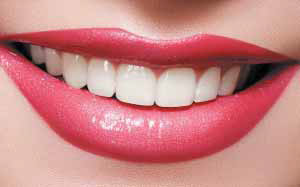
Having the perfect smile requires three elements: teeth that are in alignment, teeth that are white in color and bright, and teeth that are of appropriate size and regularly shaped, according to experts at Universal Dental.
Whitening is all about color and brightness–your smile lighting up the room. Implants, crowns, veneers and bridges deal with the shape and size of the teeth. Sometimes, the tooth itself needs fixing or the tooth is just not there. This is where implants, crowns, veneers and bridges come into play.
An implant is step one of two to getting a new tooth. An implant is a fake tooth root–a screw implanted into bone below the gum and long enough to stick out of the gum line. The crown is step two; the crown is literally placed onto the screw as the new, fake tooth. The implant acts as the crown’s anchor to keep the crown in place. Sometimes, especially with older people due to bone loss, there is not enough bone to anchor the implant. In such cases, more bone can be added in a process called bone grafting. The entire process for an implant, with healing, generally speaking, takes four to six months.
If a patient has a missing tooth, an implant is the most stable, permanent option to fix this problem. Yet, often, especially with back teeth not easily visible, people don’t replace a missing tooth. Unfortunately, this is not the best choice of action as the other teeth on the bottom or top will start moving to fill its place. The result, over time, is crooked teeth. An implant prevents this from occurring.
“We see cases almost every day where the patient did not replace a missing tooth with an implant. As a result, there is now additional work to fix alignment on top of the original problem of replacing the missing tooth. It can’t be stressed enough how it is easier and financially better to have an implant or a bridge than to let the problem go unfixed,” says Universal Dental’s Dr. John Choi, who has placed more than 10,000 implants throughout his career.
Other forms of cosmetic dentistry involve crowns and veneers. If an existing tooth is in good condition, a crown can be placed on the tooth to make it look as a good as new. Placing a crown over the entire existing tooth is why crowns are often referred to as “caps.”
Veneers, on the other hand, are like fake nails; they are a thin layer placed on the front of the tooth. They serve purely aesthetic functions to eliminate spaces between teeth (caused by irregularities in teeth size and shape, not by alignment), to cover chips or small cracks and other similar cosmetic issues. Crowns and veneers come in shades to match your existing tooth color. Ideally, whitening should be done before either of these applications is started.
Bridges are a series of crowns to fill in a missing tooth or teeth. For example, a three-crown bridge replaces one missing tooth. The middle crown of the three crowns replaces the single missing tooth.
The decision between an implant and a bridge is based on several factors. Ultimately, it requires professional judgment and is, once again, a reason why you need to pick a dentist with care.
“The best long-term solution is an implant as it is more stable. But the process is more involved than a bridge. I weigh many factors like the age of the patient and the location of the issue in the mouth. Understanding the patient is also critical,” says Dr. Michael Weiner of Universal, who has degrees from both Johns Hopkins and Columbia universities.
Then there is the matter of dentures. Millions of people around the world are missing enough teeth to require the use of a denture. Many of them struggle to keep their dentures secure, particularly in the lower jaw. If you have this problem, you already know about the embarrassment of slipping dentures, not being able to eat the foods that you love and the ineffectiveness of denture adhesives. Fortunately, there is a way to make your denture work the way it was intended: stabilize it with dental implants. Whereas a traditional removable denture rests directly on the gums and is secured by an adhesive, the overdenture is a dental implant that gives support and stability to the denture thus offering the patient a more natural use of his teeth as well as an ability to maintain his preferred diet.
There are many options to fix your teeth and many factors determine the best and most economical solution for you. The right dentist, like those at Universal Dental, has the experience and expertise to help you toward that perfect smile. Universal is a full-service specialty practice with board certified specialists on staff. They offer all aspects of dentistry. They have a full laboratory on premises which improves turnaround time, raises quality levels and reduces costs for the patient.










